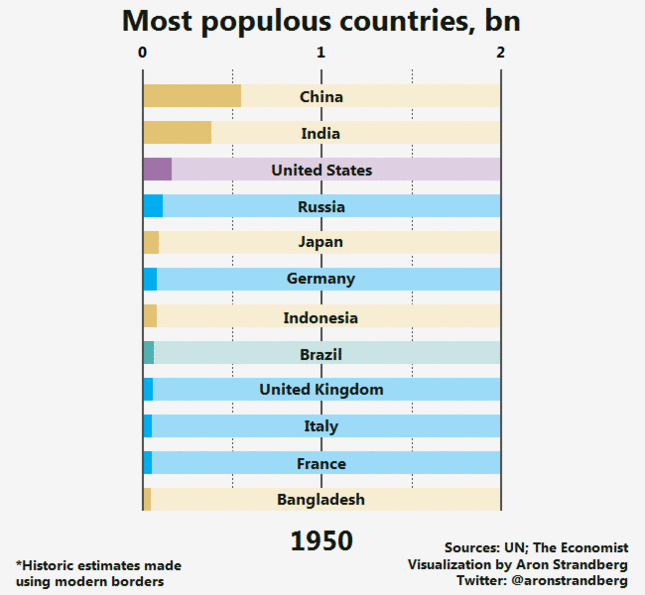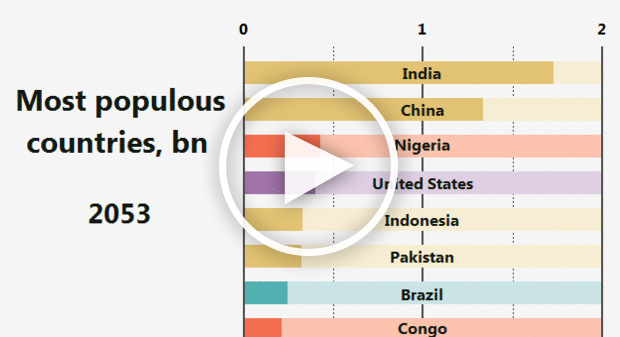Markets
Animation: 100 Years of the Most Populous Countries

Animation: 100 Years of the Most Populous Countries
“I think ageing demographics is a bigger issue in China than people think. And the problems it creates should be become evident as early as 2016.” – Stan Druckenmiller, a 2013 quote
Over the last year, we’ve been very skeptical of the near-term potential for robust global economic growth.
The media narrative throughout 2015 was that U.S. rates were on the rise, and that the American economy would finally normalize post-crisis. Stock and real estate prices reached record highs on this optimism, and many pundits expected growth and interest rates to return to more traditional levels.
Over the last few months, we’ve noticed that this narrative has changed significantly. Even though the U.S. is doing “okay” for growth, the global economy is now more entwined than ever. It’s more challenging than ever before for one economy to prop up the rest during stagnation.
Markets this year got off to their worst-ever start after jitters from China rippled through international markets. Oil has continued its plunge and is now trading near $30/bbl. Manufacturing is slowing in the United States. Europe and Japan are going nowhere, and the amount of global debt is starting to signal alarm bells.
Finally, media and investors are accepting the idea that things may not normalize the way they “should”. Instead, the question has become more fundamental: are there even any bright spots in the first place?
Back to Basics
We welcome this new found skepticism, and over the coming months part of our focus here will be to go back to the basics.
Markets aren’t rational, but we can still aim to provide rational context around the fundamentals of the market. In the long run, we believe this will help investors and regular people understand the world better.
A big part of this fundamental approach is demographics, or the changing composition of population over time.
Today’s animation, which covers the change in populations over 100 years for the most populous countries, is a starting place for this.
The first point of interest is that by about the year 2000, all European countries dropped out of the rankings. At the beginning of the animation, the United Kingdom, Germany, France, and Italy were all there. Birth rates have declined to the lowest in the world, which establishes immigration as the only potential option for economic growth. With the recent events in Paris and the current backlash against Middle Eastern immigrants, this Catch-22 becomes even more interesting and important.
Germany, in particular, faces a crucial demographic cliff. We aim to cover this in the very near future, since the country is an important engine for Europe.
Another major point of interest, as we referenced in the opening quote, is the changing demographics of China. In the next decade or so, China’s population will stop growing altogether – and then it will start shrinking. This is the predictable aftermath of China’s one-child policy for many decades. The country still has a giant portion of the population that will continue to move up the ladder economically, but we will be looking at what these circumstances could mean as they loom closer.
Lastly, the rise of India and Nigeria can’t be understated in importance. Both are home to the fastest growing cities in the world. Nigeria will pass the U.S. to become the third largest country in the world by population in the coming decades, and India could be the world’s next China.
When will this potential growth factor into the economy and investments? That’s something else we plan to look at as it becomes more relevant.
Original graphic by: Aron Strandberg
Markets
Visualizing Global Inflation Forecasts (2024-2026)
Here are IMF forecasts for global inflation rates up to 2026, highlighting a slow descent of price pressures amid resilient global growth.

Visualizing Global Inflation Forecasts (2024-2026)
Global inflation rates are gradually descending, but progress has been slow.
Today, the big question is if inflation will decline far enough to trigger easing monetary policy. So far, the Federal Reserve has held rates for nine months amid stronger than expected core inflation, which excludes volatile energy and food prices.
Yet looking further ahead, inflation forecasts from the International Monetary Fund (IMF) suggest that inflation will decline as price pressures ease, but the path of disinflation is not without its unknown risks.
This graphic shows global inflation forecasts, based on data from the April 2024 IMF World Economic Outlook.
Get the Key Insights of the IMF’s World Economic Outlook
Want a visual breakdown of the insights from the IMF’s 2024 World Economic Outlook report?
This visual is part of a special dispatch of the key takeaways exclusively for VC+ members.
Get the full dispatch of charts by signing up to VC+.
The IMF’s Inflation Outlook
Below, we show the IMF’s latest projections for global inflation rates through to 2026:
| Year | Global Inflation Rate (%) | Advanced Economies Inflation Rate (%) | Emerging Market and Developing Economies Inflation Rate (%) |
|---|---|---|---|
| 2019 | 3.5 | 1.4 | 5.1 |
| 2020 | 3.2 | 0.7 | 5.2 |
| 2021 | 4.7 | 3.1 | 5.9 |
| 2022 | 8.7 | 7.3 | 9.8 |
| 2023 | 6.8 | 4.6 | 8.3 |
| 2024 | 5.9 | 2.6 | 8.3 |
| 2025 | 4.5 | 2.0 | 6.2 |
| 2026 | 3.7 | 2.0 | 4.9 |
After hitting a peak of 8.7% in 2022, global inflation is projected to fall to 5.9% in 2024, reflecting promising inflation trends amid resilient global growth.
While inflation has largely declined due to falling energy and goods prices, persistently high services inflation poses challenges to mitigating price pressures. In addition, the IMF highlights the potential risk of an escalating conflict in the Middle East, which could lead to energy price shocks and higher shipping costs.
These developments could negatively affect inflation scenarios and prompt central banks to adopt tighter monetary policies. Overall, by 2026, global inflation is anticipated to decline to 3.7%—still notably above the 2% target set by several major economies.
Adding to this, we can see divergences in the path of inflation between advanced and emerging economies. While affluent nations are forecast to see inflation edge closer to the 2% target by 2026, emerging economies are projected to have inflation rates reach 4.9%—falling closer to their pre-pandemic averages.
Get the Full Analysis of the IMF’s Outlook on VC+
This visual is part of an exclusive special dispatch for VC+ members which breaks down the key takeaways from the IMF’s 2024 World Economic Outlook.
For the full set of charts and analysis, sign up for VC+.
-

 Money6 days ago
Money6 days agoCharted: Which Country Has the Most Billionaires in 2024?
-

 Energy2 weeks ago
Energy2 weeks agoRanked: The Top 10 EV Battery Manufacturers in 2023
-

 Countries2 weeks ago
Countries2 weeks agoCountries With the Largest Happiness Gains Since 2010
-

 Economy2 weeks ago
Economy2 weeks agoVC+: Get Our Key Takeaways From the IMF’s World Economic Outlook
-

 Demographics2 weeks ago
Demographics2 weeks agoThe Countries That Have Become Sadder Since 2010
-

 Money2 weeks ago
Money2 weeks agoCharted: Who Has Savings in This Economy?
-

 Technology1 week ago
Technology1 week agoVisualizing AI Patents by Country
-

 Economy1 week ago
Economy1 week agoEconomic Growth Forecasts for G7 and BRICS Countries in 2024















